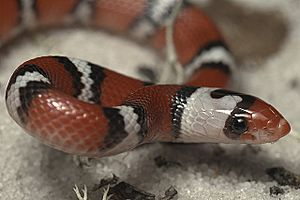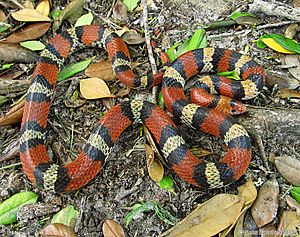Scarlet snake facts for kids
Quick facts for kids Scarlet snake |
|
|---|---|
 |
|
| scarlet snake | |
| Conservation status | |
| Scientific classification | |
| Genus: |
Cemophora
|
| Species: |
coccinea
|
| Synonyms | |
|
|
The scarlet snake (Cemophora coccinea) is a beautiful snake. It is a species of non-venomous snake. This means it is not harmful to humans. It belongs to the Colubridae family of snakes.
Scarlet snakes live in the southeastern United States. There are two main types, or subspecies, of the scarlet snake. Another type, the Texas scarlet snake, used to be considered a subspecies.
Contents
About the Scarlet Snake
The scarlet snake is a fairly small snake. It usually grows to be about 14 to 26 inches (36–66 cm) long. Its back is light gray. It has bright red, white, or yellow blotches. These blotches have black borders.
The snake's belly is usually a plain light gray or white color. The blotches on its back can sometimes look like bands or rings. This can make people confuse it with other snakes. For example, it might be mistaken for the coral snake, which is venomous. It can also look like the harmless Scarlet kingsnake.
Where Scarlet Snakes Live
Scarlet snakes are found only in the United States. They live in many states, including Texas, Florida, Georgia, and the Carolinas. You can also find them in states like Kentucky, Illinois, and Indiana. Sometimes, small groups are found in New Jersey and Missouri.
These snakes prefer open forests. They like areas with sandy soil. They also like places with lots of leaves and other plant material on the ground.
In Indiana, the scarlet snake is an endangered species. This means there are not many left. In New Jersey, experts want to list it as "threatened." This is because their numbers are going down.
The main reasons for fewer scarlet snakes are:
- Losing their homes (habitats)
- Being caught illegally for pets
- Getting hit by cars on roads
- Being killed by people on purpose
Scarlet Snake Behavior and Diet
Scarlet snakes are nocturnal. This means they are active mostly at night. They are usually seen during the summer months. During the day, they hide. You might find them under logs or piles of pine needles.
At night, they often cross roads. They are usually looking for food. Scarlet snakes eat different things. They like lizards and small rodents. They also eat the eggs of other snakes, lizards, and turtles. Sometimes, they even eat other snakes.
Scarlet snakes have special teeth at the back of their mouth. These teeth are very sharp. They use them to cut open large reptile eggs. They might squeeze an egg to get the insides out. Or, they might push their head into the egg to break it open. Smaller eggs are swallowed whole.
Scarlet Snake Reproduction
Not much is known about how scarlet snakes reproduce. They are oviparous. This means they lay eggs. A female usually lays 2 to 9 eggs at a time. Five eggs is a common number.
Breeding happens in the spring. The eggs are laid in the summer. They are often laid in burrows or under rocks. The eggs hatch about two months later. This usually happens in late summer or fall.
Predators and Defense
Some animals hunt and eat scarlet snakes. These include other snakes, like the coral snake. Birds and mammals that eat snakes are also predators.
Scarlet snakes usually do not bite humans. If you pick one up, it might release a bad-smelling odor. This is a way for them to defend themselves.
Protecting Scarlet Snakes
The biggest dangers to scarlet snakes are:
- Their homes being destroyed for buildings.
- Getting hit by cars on roads.
Other threats include people catching them illegally for pets. Also, some people kill them on purpose. Protecting their habitats is very important for their survival.
Types of Scarlet Snakes
There are two recognized types of scarlet snakes:
- Cemophora coccinea coccinea (Blumenbach, 1788) – This is called the Florida scarlet snake.
- Cemophora coccinea copei Jan, 1863 – This is known as the northern scarlet snake.
Images for kids
-
Cemophora coccinea copei, Northern scarlet snake







